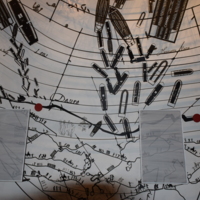
Freedom Park
Freedom Park opened in 2006 having been established as a Legacy Project of South Africa’s second democratically-elected president, Thabo Mbeki. Nine sites were established as Legacy Projects, receiving ample state funding as spaces considered priority sites in preserving national history. Freedom Park was conceived as a national memorial, with a central feature being the 'Wall of Names'; a memorial wall displaying the names of people associated with eight ‘struggle’ epochs which the site considers to define South African history. Elsewhere, evidence of the influence of Mbeki’s ‘African renaissance’ philosophy is prominent. Memorial features in the ‘Isivivane’ area include a symbolic burial ground titled ‘Lesaka’, and ‘Lekgotla’, an African meeting place surrounding the trunk of a uMlahlankosi tree.
A museum, named //hapo (‘dream’ in Khoi) opened in 2013, introducing explicitly didactic content to Freedom Park for the first time. Much like the ‘Wall of Names’, this is grouped into eight ‘struggle’ epochs. It weaves an Africanist narrative beginning by positing the continent as the cradle of mankind, and ending by suggesting that Africans can look to the past to solve the problems of the present, many of which it links with European colonisation. Freedom Park operates a substantial educational and visitor tour programme.
Freedom Park is the only museum in South Africa outside the former slave trading epicentre which is now the Western Cape to cover slavery in any detail. Slavery features as an epoch on both the ‘Wall of Names’ and in //hapo. With the former, it is not clear whether the names displayed are actually those of people enslaved in South Africa, as some of the names are more indicative of transatlantic slave naming patterns. In //hapo, the epoch titled ‘Peopling’ details how Europeans viewed Africa as a market for human beings. A number of artefacts – some of which were created for the museum – depict African life prior to the arrival of Europeans, whilst an installation by the Johannesburg-based artist Clive van den Berg portrays departure. Slavery depicted in //hapo therefore is transatlantic slavery, rather than the very different system of slavery evident in South Africa.
![Mary Patten, Douglass Street Mural, 389 Douglass St, Brooklyn, NY, 1976 [destroyed 1989].jpg Mary Patten, Douglass Street Mural, 389 Douglass St, Brooklyn, NY, 1976 [destroyed 1989].jpg](https://486312.frmmmguz.asia/files/square_thumbnails/95232a9ffb9e9bde28fc73b69fc9109a.jpg)
Douglass Street Mural
Mary Patten painted Douglass Street Mural – Cityarts Workshop’s first Brooklyn-based project – in 1976. Over a five-month period, Patten led a group of 20 teens and adults to develop various themes for the mural that would be located on Douglass Street in the Park Slope area of Brooklyn - an area more commercial than residential at the time. Community meetings and bilingual flyers filled the neighbourhood in the hope of garnering community input and consensus over the choice of imagery. The three-storey mural takes advantage of the building's structure by presenting the image as book pages waiting to be read. The dystopian nightmare to the right-hand side of the mural attempts to encroach on the multicultural utopian melting pot to the left, only to be fended off by workers and important figures from U.S. history. Folded into the Puerto Rican flag and the red, white and green banner of the African National Congress, are the images of Harriet Tubman, pointing towards the nightmare-scape, alongside Frederick Douglass, Lolita Lebrón, Malcolm X and H. Rap Brown. Under the imperialist eagle and puppet-like figure in its talons, Patten depicts a recent firebombing that had destroyed the homes of several Black families a few blocks away. Speaking of the large rainbow in the image, the muralist incorporated it to show "what is possible when people work and fight together to create what we need: a community school that provides quality education; people sharing skills and tools; dancing together; making music and painting a mural."The mural sought to convey hope and determination in the face of oppression. But by the 1980s, the mural had become obscured by new housing developments.